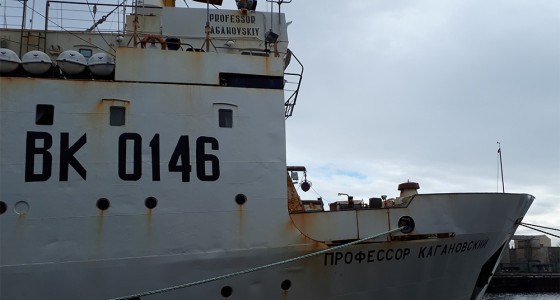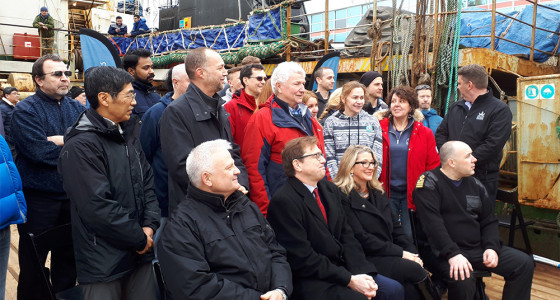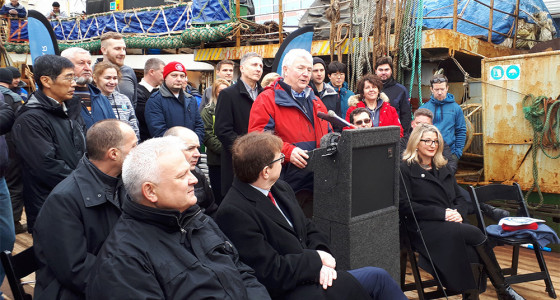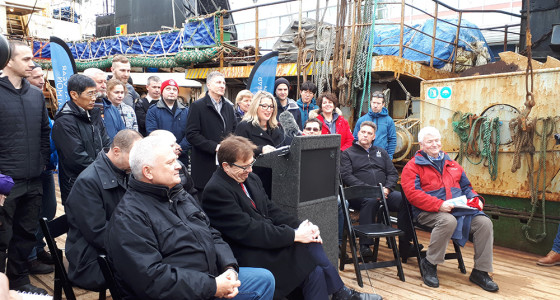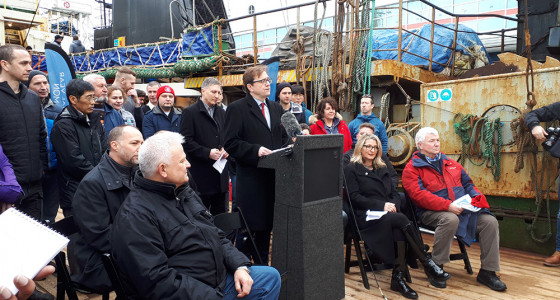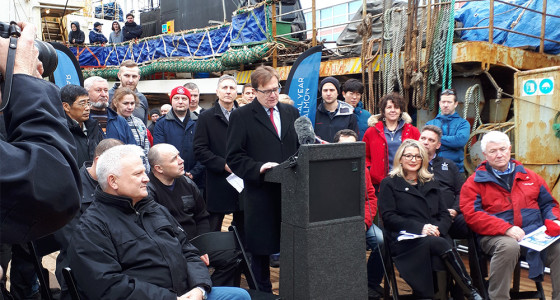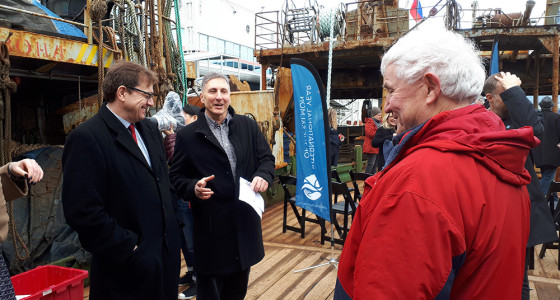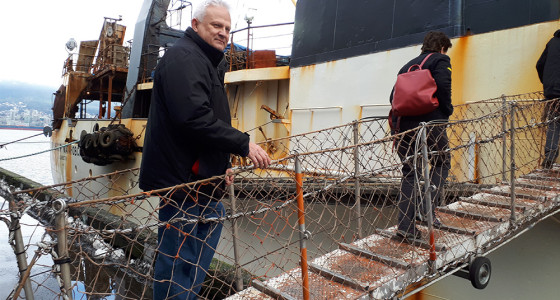 The scientific community believes that one-third of all Pacific salmon spend the winter in the Gulf of Alaska. Pacific salmon from Canada, Japan, Korea, Russia, and the United States are believed to mix together in the Gulf of Alaska, and any impacts to salmon here, can impact salmon around the Pacific Rim. With recent declines in salmon returns, more research was required, though there have been limited surveys of the Gulf of Alaska.
The scientific community believes that one-third of all Pacific salmon spend the winter in the Gulf of Alaska. Pacific salmon from Canada, Japan, Korea, Russia, and the United States are believed to mix together in the Gulf of Alaska, and any impacts to salmon here, can impact salmon around the Pacific Rim. With recent declines in salmon returns, more research was required, though there have been limited surveys of the Gulf of Alaska.
The major objectives of this Gulf of Alaska Expedition are to use DNA to identify the stock specific rearing areas for all five species of salmon, and to determine their abundances and condition. This is the first time that this information will be available and it will be shared with the general public.
The expedition team consists of 21 researchers from Canada, the United States, Russia, Japan, and Korea – all Pacific salmon producing countries. They have gathered on the Russian Vessel the Professor Kaganovskiy for a month long voyage in the Gulf of Alaska – the first winter-at-sea international research collaboration, surveying of abundance and condition of salmon.
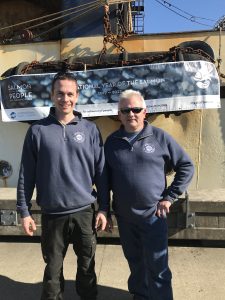
Dr. Brian Hunt and Dr. Evgeny Pakhomov
At a reception at Vancouver Aquarium that evening, Dr. Pakhomov joined Mark Saunders from the North Pacific Andromonous Fish Commission and Dr. Dick Beamish, professor emeritus, Pacific Biological Station, and driving force behind the expedition, to give an overview of some of the preliminary finding from the voyage.
March 14
My impressions
By Evgeny Pakhomov
March 14, 2019 (ship time)
48 43.3N 138 16.2W
95.4 degrees at 8.9 knots
I consider myself a field going scientist and as of today have taken part in over 4 dozen research and fisheries voyages all over the globe, from tropics to Polar regions. They lasted from day trips to 6.5 months’ voyages. With the experience usually comes comfort and last decade I was sailing on high end research ships, such as new Australian National Research Platform RV Investigator or the German icebreaker RV Polarstern. Both of those ships have spacious research space, equipped with the latest technology and instrumentation and can accommodate over 40 scientists making them very efficient research platforms. However, my scientific career started on fishing research ships working mostly in the Southern Ocean. It was thus something nostalgic to go on board RV Professor Kaganovskiy to the North Pacific as a major contribution to the International Year of the Salmon. The least to say, it was like going back in time and share this experience with fellow countrymen of my origin. Prof. Kaganovskiy is over 30 years old, German build fisheries research ship, which is well equipped to conduct fisheries type of research. Despite perhaps a tight lab space, it does have several dedicated spaces, which house hydrological and marine chemistry teams, the zooplankton team and the ichthyologic team. There is also a relatively spacious space one deck below the trawling deck, which was set up for fish processing. It is conveniently placed right next to the deep freezers and the ship does have ample -20
Following multi-year efforts of Dr. V. Shuntov, the TINRO Center adopted a “complex or comprehensive approach” for the fisheries research. The main purpose of it is not only to concentrate on the fish, which is easy to do for the “resource” oriented organizations. Instead, it covers as much as possible the environment from major physical characteristics, macronutrients, zooplankton, micronekton, and indeed the fish. It is astonishing that all those components could be effectively monitored. Of course, as biological oceanographer, I could say that with the current sampling we still miss the main prey items of fish, salmon in our particular case. However, it is the best that can be done with the limited space available on the ship. It should be also mentioned that the Prof. Kaganovskiy is well designed to conduct grid surveys. It is also reflected in the number of scientific crew (17 in total) which can be comfortably housed by the ship. The integral and perhaps most critical part of the “comprehensive approach” is in field processing of samples, including oceanography, chemistry, zooplankton, and micronekton composition, as well as fish biology and diet. This in contrast to normal research voyages, where majority of time is dedicated to collecting information/samples and bringing them to the comfort of labs for processing. Of course, something is collected, frozen, and preserved for future lab analysis even during our expedition. Nevertheless, the Prof. Kaganovskiy research crew is trained to process almost all samples at sea. This is something very critical during fisheries voyages because the information should be promptly analysed and made available for a scientific advice to the commercial fleet. This also means that the ship and crew should work like a clockwork. Indeed, it was impressive to see high professionalism among almost everyone onboard!
I would like to say something about the food. It was a real “Russian cuisine”, basic but very nutritious and my impression was that Westerners liked it a lot! I can 100% attest that it was just delicious and in many ways educational to non-Russian people, but very childhood nostalgic to me!
Despite the ship not being very young, it does the job and works well. The workmanship of crew, officers and Capitan Aleksandr Pakker is applaudable. Crew is efficient on the deck and the Capitan is on the bridge during every trawl, either overseeing it or driving it when seas are rough. It should be noted that we were super lucky as the first two-thirds of the voyage; we had excellent weather and calm seas. This allowed us to complete 3 stations per day, which included just steaming along a distance of 180 nautical miles. We kept this pace for a few weeks and in the end we were able to complete almost all planned stations. As everything good always comes to the end, towards the completion of the survey the seas became challenging. That slowed us down but did not stop the survey.
The efficiency at the station is worth mentioning. I was not on many ships that allowed to work from two winches simultaneously. For example, CTD (water profiler, usually goes down to 1000 m measuring temperature, salinity, oxygen and plant pigments) and zooplankton nets were deployed at the same time from the front and middle part ship winches. Just this saved us about 40 to 60 minutes at every station. Officers would keep ship on the wind and instruments and nets would go into the water almost without an angle and this would be done with the headwinds sometimes blowing with the speed of up to 25 m/sec! This can only be compared to airplane acrobatics!!!
It is hard for me to compare this survey to others as it would be comparing apples with oranges. Each survey by default is unique. The best is to compare what has been achieved during the voyage. The bottom line is that with limited abilities, time and resources, we have done a tremendous job and successfully completed the first Northeastern Pacific oceanographic and fish survey during the challenging seasonal period! This would not be possible without the dedication of the crew and scientists. Particularly, the workmanship of Russian research team should be praised. It consisted mostly of enthusiastic and knowledgeable young scientists, although our zooplankton person, Alexander Slabinskii, celebrated his 69th birthday at sea, and his zooplankton taxonomy knowledge is just exceptional! I would say that the entire research team worked so well together that it made my job as the Chief Scientist super easy. I may be biased but there is an unspoken connectivity among people who shared limited space for a long time during the field work. The best people could say about you after such experience that “I would go with you at sea again anytime anywhere…”. I can proudly say that with the team during this voyage!
March 13
"Took about 16 hours last night to go between stations as seas and weather forced us to zig zag. To top it off our last two sets have been empty!
All feeling a little weather worn. Even the cat. In these seas she stands in what we're calling the "basset hound stance"; with her feet splayed out to the sides to help her keep
balance. We will try to get a picture.
We expect to have another set in tonight and are all hoping for fish again." ~ Chrys Neville, Pacific Biological Station, Fisheries and Oceans Canada
Assorted photos
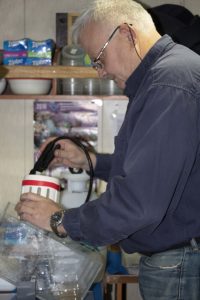 Evgeny Pakhomov washing down plankton jars. All photos ©Chrys Neville |
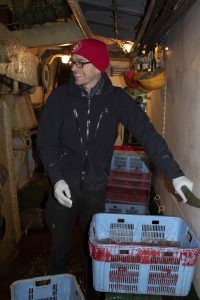 Brian Hunt. All photos ©Chrys Neville |
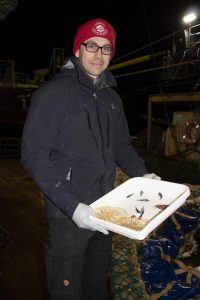 Brian Hunt. All photos ©Chrys Neville |
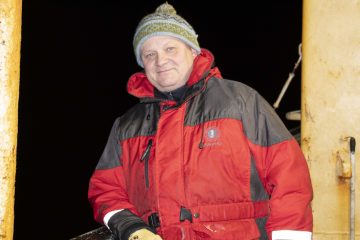 Evgeny Pakhomov All photos ©Chrys Neville |
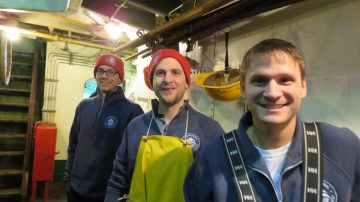 Brian Hunt, Christoph Deeg and Charles Walters. All photos ©Chrys Neville |
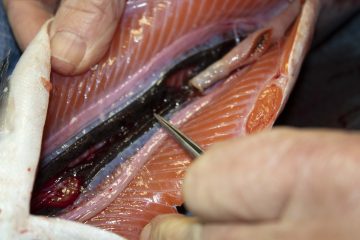 Removing tissue for testing in lab. All photos ©Chrys Neville |
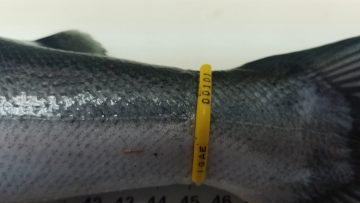 All photos ©Chrys Neville |
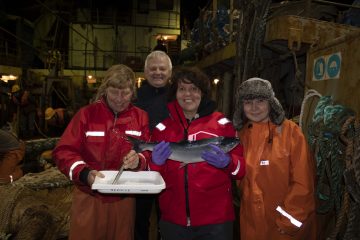 (l to r): Laurie Weitkamp, Evgeny Pakhomov, Chrys Neville, Svetlana Esenkulova. All photos ©Chrys Neville |
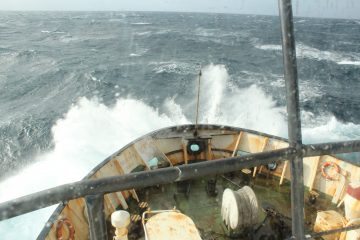 Stormy weather. All photos ©Chrys Neville |
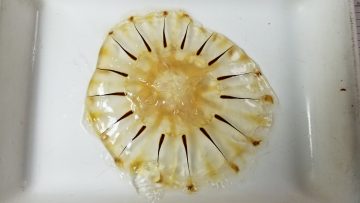 Chrysaora jellyfish. All photos ©Chrys Neville |
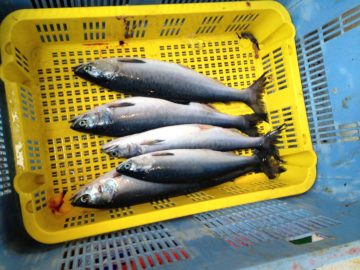 The elusive pink salmon. All photos ©Chrys Neville |
Using the nets
March 4
"Our catches have picked up from the northern part of the survey area, although sockeye numbers have diminished. This morning we caught chum, pink and coho salmon. These are the first pink salmon encountered since the first days of the survey.
We had 4 killer whales cross our path yesterday. Not the species I expected to see out here but possibly a component of the offshore group. Additionally there was a pinniped sighted. Unfortunately, we do not have an ID; likely a fur seal.
Had 2 fin whales off our starboard just as we were hauling the net. I was surprised to walk out of the fish lab and see them only about 100m away.
We are starting to see some trends and patterns in our fish catch and in the oceanography. One observation that is interesting is that visually, there appears to be a variation in the condition of the salmon by species. In general, chum salmon we are catching are skinny. In contrast, the second year sockeye salmon we have caught are fat and healthy looking; we can even easily see a layer of fat under their skin. The sockeye that are in their first winter at sea (based on size) are looking more comparable to the chum salmon. Additionally, the ocean chemistry indicates that the spring bloom is starting out here. Not surprising with the sun and calm seas!" ~ Chrys Neville, Pacific Biological Station, Fisheries and Oceans Canada
March 1, 2019
"We are about to hit half way in our voyage. The time flew super-fast and it seems that in about 2 weeks we will be wrapping up already. We have completed 27 stations by now and the weather was very good to us thus far. We did not lose any days to the bad weather and there is hardly any wind or waves! Pretty amazing for the winter North Pacific. This is likely because high pressure system is stationary over our working region and hopefully will stay there for another at least one week. We are regularly catch salmon but our catches are not big and range from 1 to max 22 salmon thus far. We catch mostly sockeye in the northern part of the survey and pink only was in the south-eastern part of the survey. We do catch coho and chum all over the survey but not in big numbers. We even caught two large chinooks!
The station routine is simple; we arrive at the station and deploy CTD to a 1000 m. At the same time, which is unusual for the western voyages, we allowed to deploy plankton nets from the middle of the ship. So, two Juday nets, 50-0 and 200 m, are completed first and then we do Bongo down to 250 m. Usually, it tales about the same time as the CTD, so immediately after that we deploy a midwater trawl in the 0-30 m layer and trawl for 1 hour at about 4.5 knots. When the trawl is nearly completed and taken on board, we deploy a neuston net for 15 minutes at speed of 2.5 knots and then proceed to the next station. Pretty boring routine and there is almost nothing outside except a few odd birds and few container ships on the horizon occasionally. Well, there are good sunsets and sunrises but otherwise this is it. When we were working in the American EEZ, we expected the US coastguard to visit us but it did not occur. The food is great, albeit very Russian, but everybody seems to like it. One thing is special in this voyage, while we freeze and formalin a lot, lots of processing is happening as well. The other day, we have caught a huge black rockfish (>3.5 kg) in the middle of nowhere, and it after the analysis went to the kitchen! Currently, everybody is settled into a routine and initial frenzy after each trawl seems to go away. We are though still hoping for large salmon catch (>50 or 100 fish).
We are getting some very interesting results. Besides fish news mentioned above, in the south-western part of the Survey, we caught lots of salps, seemingly Salpa aspera, while the northern part is packed with the jellyfish, mostly Chryosora. The methodology of stock ID seems to work at sea and Chris made some stock IDs for coho and chinook. We catch lots of squid in the middle of survey, but not much in the northern part. Except south most transect zooplankton dominated by Neocalanus crystatus." ~ Evgeny Pakhomov
February 28, 2019
In-field genetic stock identification – Dr. Christoph Deeg, Pacific Biological Station, Fisheries and Oceans Canada
"To determine the origin of the salmon captured in the Gulf of Alaska between February 19th and February 25th stock specific genetic markers of twenty-nine coho salmon were analyzed onboard the research vessel Professor Kaganovskiy by using a mobile DNA sequencing platform. The results were compared to a baseline of known genetic signatures from specific stocks provided by Terry Beacham at DFO. For eight of the tested salmon, the genetic signature allowed statistically significant attribution to stocks of known origin. Three of the coho salmon originated from the Skagit River in Washington State and five from the Lower Stikine River that flows from northern BC into Alaska. The data for the remainder of the fish was below the limit for statistical significance, but ten were attributed to mainland streams and rivers along the Hecate Strait, and the remainder of the fish appeared to originate from the Skagit and Stikine rivers, similar to the confirmed specimens captured in the same sets." ~ Chrys Neville, Pacific Biological Station, Fisheries and Oceans Canada
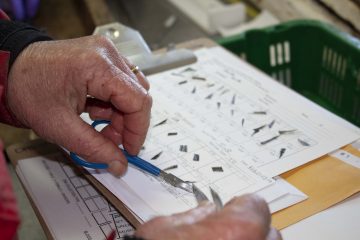 Collecting DNA from fish. All photos ©Chrys Neville |
 Taking tissue for DNA analysis. All photos ©Chrys Neville |
February 27, 2019
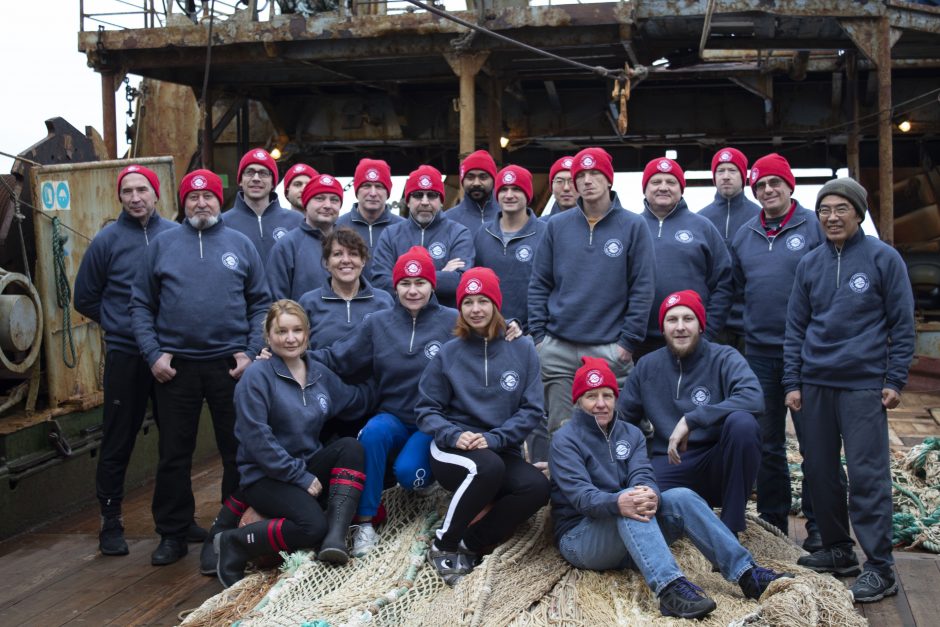
Expedition team. All photos ©Chrys Neville
February 26, 2019
"We are now crossing into US waters. Doubling up our next set and will do a deeper set at 30m about 5 nm before next station. We will replicate at surface on station. We want to get idea of vertical distribution as water mass stable. In addition, we now have to have full mammal watch as in US EEZ. However, seas remain amazing and sun is even out with only about 60% cloud today." ~ Chrys Neville, Pacific Biological Station, Fisheries and Oceans Canada
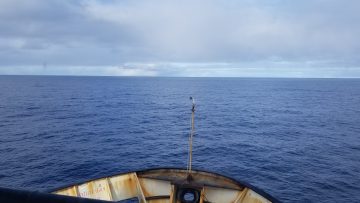 All photos ©Chrys Neville |
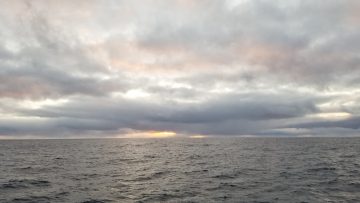 All photos ©Chrys Neville |
February 24, 2019
"We just finished breakfast after completing our 4am set. It was our first set on the line further north and we caught our first sockeye and our first Chinook! Good set actually: all but pink salmon. 6 sockeye, 6 chum, 2 coho and 1 chinook. The chinook was large over 4kg. [NOAA researchers are] wagering it is a Columbia river fish. The sockeye were definitely first winter at sea, small but not skinny like some of the fish we saw early on. A couple even had noticeable fat under their skin. The coho and chum were small but not skinny. There were squid in the catch but have not looked at full by-catch list to see other species." ~ Chrys Neville, Pacific Biological Station, Fisheries and Oceans Canada
February 24, 2019
"We just finished breakfast after completing our 4am set. It was our first set on the line further north and we caught our first sockeye and our first Chinook! Good set actually: all but pink salmon. 6 sockeye, 6 chum, 2 coho and 1 chinook. The chinook was large over 4kg. [NOAA researchers are] wagering it is a Columbia river fish. The sockeye were definitely first winter at sea, small but not skinny like some of the fish we saw early on. A couple even had noticeable fat under their skin. The coho and chum were small but not skinny. There were squid in the catch but have not looked at full by-catch list to see other species." ~ Chrys Neville, Pacific Biological Station, Fisheries and Oceans Canada
February 23, 2019
Collecting and checking zooplankton
All video @Stuart McNish/ All photos ©Chrys Neville
"We are currently starting station 10. Seas have picked up a bit but still only 2-3m. We will be turning north after this set as we dropped the most western line of grid. Small catch this afternoon - only 1 chum. However, we caught a large female Belonella borealis squid. She was alive but on her last legs as had she released her eggs. However, she had spermatocytes visible in her from 2 or 3 males that would have spawned with her. She is usually very deep water and only in surface as on her last legs." ~ Chrys Neville, Pacific Biological Station, Fisheries and Oceans Canada
February 21, 2019
"The weather is good at the moment and we are moving to the third station on the grid. In the first two we caught 9 pinks and 1 coho, so we are in the good start. Everything works thus far and crew is super dedicated and professional. Everything onboard is basic but works." ~ Evgeny Pakhomov
On February 16th, the expedition team met with dignitaries, including the Honourable Jonathan Wilkinson, Minister of Fisheries, Oceans and the Canadian Coast Guard, and the Honourable Lana Popham, Minister of Agriculture for the Province of British Columbia. Other distinguished guests included Mark Saunders, Director, International Year of the Salmon, North Pacific Anadromous Fish Commission (IYS-NPAFC), Dr. Dick Beamish, Fisheries and Oceans Canada Scientist Emeritus, Timothy Sucic, Pacific Salmon Foundation, and John Paul Fraser, BC Salmon Farmers Association.
 The Russian research vessel the Professor Kaganovskiy travelled from Vladivostok to Vancouver, where it will pick up its full complement of 21 scientists. The Russian research vessel the Professor Kaganovskiy travelled from Vladivostok to Vancouver, where it will pick up its full complement of 21 scientists.
The expedition will leave Vancouver, BC, Canada on February 16 and will follow the track outlined in red. A grid of 72 stations approximately 60 nautical miles apart will be occupied in the Gulf of Alaska. Some of the stations were studied in the 1960’s and 1970’s by Japanese and Canadian researchers. At each station a dizzying array of gear will be used to study the oceanography and the animals, including salmon in the upper 50m. A midwater trawl with a mouth opening of 50m will collect fish and invertebrates from an hour-long tow. The animals caught will be identified and samples. In addition to typical observations like the length and sex of the fish, samples will be taken to learn things like how old the fish is, what freshwater stock does is belong to, what was it eating, what pathogens is it carrying and how healthy physiologically is the fish. Geneticists will be testing a new handheld genetic sequencer that will potentially allow stock identification at sea for the first time. A live tank will be tested in the trawl to catch fish undamaged that will be tagged with satellite tags that when returned will tell researchers where the fish has been since it was tagged. How salmon navigate is still a mystery and these tags will help test the idea that they follow the earths magnetic lines. At each station probes will be sent down 1,000m to measure how temperature, salinity, pH change with depth and plankton nets will be used to sample the food for salmon in the form of primary producers like algae and secondary producers like krill that feed on the algae and are feed on in turn by salmon. All of the salmon will be frozen and brought back for further study. |
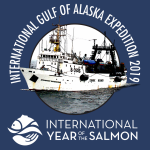 Visit the Gulf of Alaska Expedition official website |
UBC's Institute for the Oceans and Fisheries have two members on this expedition.
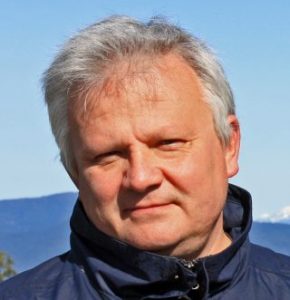
Dr. Evgeny Pakhomov
Dr. Evgeny Pakhomov is Professor and Director of the Institute for the Oceans and Fisheries. He is the Chief Scientist on this expedition because of his over 35 years of sea-going experience, including being a Chief Scientist on numerous occasions and because of his international reputation for the understanding and promotion of the ecosystem approach to the fisheries research.
Evgeny is a graduate of the Russian Academy of Sciences, he has more than 30 years of research experience as a biological oceanographer. His research focuses on understanding physical-biological interactions and ecosystem response to climate change or global warming, from the Antarctic to coastal British Columbia and from coastal realms to high seas. His research interests span species ecology (from plankton to fish), ecosystem structure and function, and biochemical coupling. He has more than 200 publications.
“I am at heart a sea- going, field scientist and I am anxious to be back at sea”.
As a biological oceanographer, Evgeny is most interested in zooplankton (creatures from 0.2 to 2 cm in size) and micronekton (creatures from 2 to 20 cm in size). Both of those play critical roles in the pelagic ecosystems because they link primary producers (mainly microscopic plants) with larger fish, including salmon. He is, therefore, very interested in studying what food the salmon consume.
For most of his career, Evgeny worked in the Southern Ocean uncovering questions related to how the pelagic ecosystems are structured and work. His interest in this North Pacific expedition is related to the pelagic ecosystem functioning. As we know little about this open ocean ecosystem where Pacific salmon spend much of their time, Evgeny believes that this voyage is a unique opportunity to study salmon.
Dr. Pakhomov is a recipient of the Vice-Chancellor’s Distinguished Research Award, Rhodes University, South Africa; the Alexander von Humboldt Foundation Research Award, Germany; the New Opportunities Fund Award from the Canadian Fund for Innovation; and the Senior Early Career Fellowship from the Peter Wall Institute for Advanced Studies at the University of British Columbia. He has strong links to several laboratories and institutions worldwide, including the Alfred Wegener Institute for Polar and Marine Research in Germany, the British Antarctic Survey, NIWA in New Zealand, the University of Hawaii, and Rhodes University, South Africa.
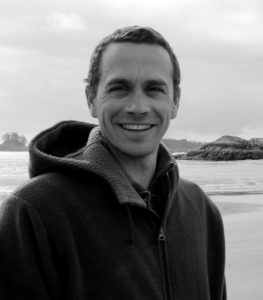
Dr. Brian Hunt
Brian is a biological oceanographer by training with broad interests in the structure and function of pelagic marine ecosystems, and their response to climate forcing and anthropogenic impacts. He has participated in ten Antarctic research voyages, as well as voyages in the tropical and temperate South Pacific, Mediterranean, North Pacific and Arctic.
Brian uses a range of biogeochemical tools including stable isotopes and fatty acids for his research on food web dynamics which is a focal element of his research. Brian is currently using biogeochemical approaches to resolve salmon life history experience, specifically feeding ecology and habitat use, and their interactive effect on salmon health. During the Gulf of Alaska Expedition, Brian will be collecting samples for comprehensive biogeochemical analysis of salmon food webs in the Northeast Pacific, from plankton to the salmon. The resulting data will be used to parameterize salmon food web linkages, validate a recently developed North Pacific Isoscape model, and validate biogeochemical proxies of salmon feeding ecology and health that can be measured in fish on the spawning ground to reveal oceanic life history experience.
Collecting samples for comprehensive biogeochemical analysis of salmon food webs in the Northeast Pacific, from plankton to the salmon
Since moving to UBC in 2006, British Columbia coastal ecosystems have become a major research focus. After his initial involvement in the Tula Foundation funded Rivers Inlet Ecosystem Study between 2008 and 2011, Brian has worked extensively in partnership with the Tula Foundation’s Hakai Institute in developing Oceanographic Observatories in British Columbia, and conducting research into the early life history of juvenile salmon and herring. This work is done in collaboration with a growing network of Canadian researchers, including the Department of Fisheries and Oceans, First Nations, non-governmental organizations (NGOs) and other academic institutes.
| Driven by the vision that a high seas winter survey of salmon in an International Year of the Salmon could be a transformative vehicle to galvanize five countries around a pulse of effort to understand the mechanisms driving the production of salmon, Dr. Dick Beamish has led a campaign to make it a reality. Dr. Beamish an emeritus scientist originally with Fisheries and Oceans Canada and Dr. Brian Riddell, the Executive Director of the Pacific Salmon Foundation led the funding drive that raised $1.2M to charter the Russian Vessel the Professor Kaganovsky. Donors included private individuals, NGO’s, Provincial and Federal governments.
The expedition is a Signature Project of the International Year of the Salmon (IYS) that also became a reality. The IYS is 5-year initiative to establish the conditions for resilience for salmon and people. The hemispheric partnership is being led by the North Pacific Anadromous Fish Commission, the North Atlantic Salmon Conservation Organization (NASCO) and a number of NGO’s, private sector, government and academic organizations. Source: https://yearofthesalmon.org/gulf-of-alaska-expedition/ |
 Visit the Gulf of Alaska Expedition official website |
